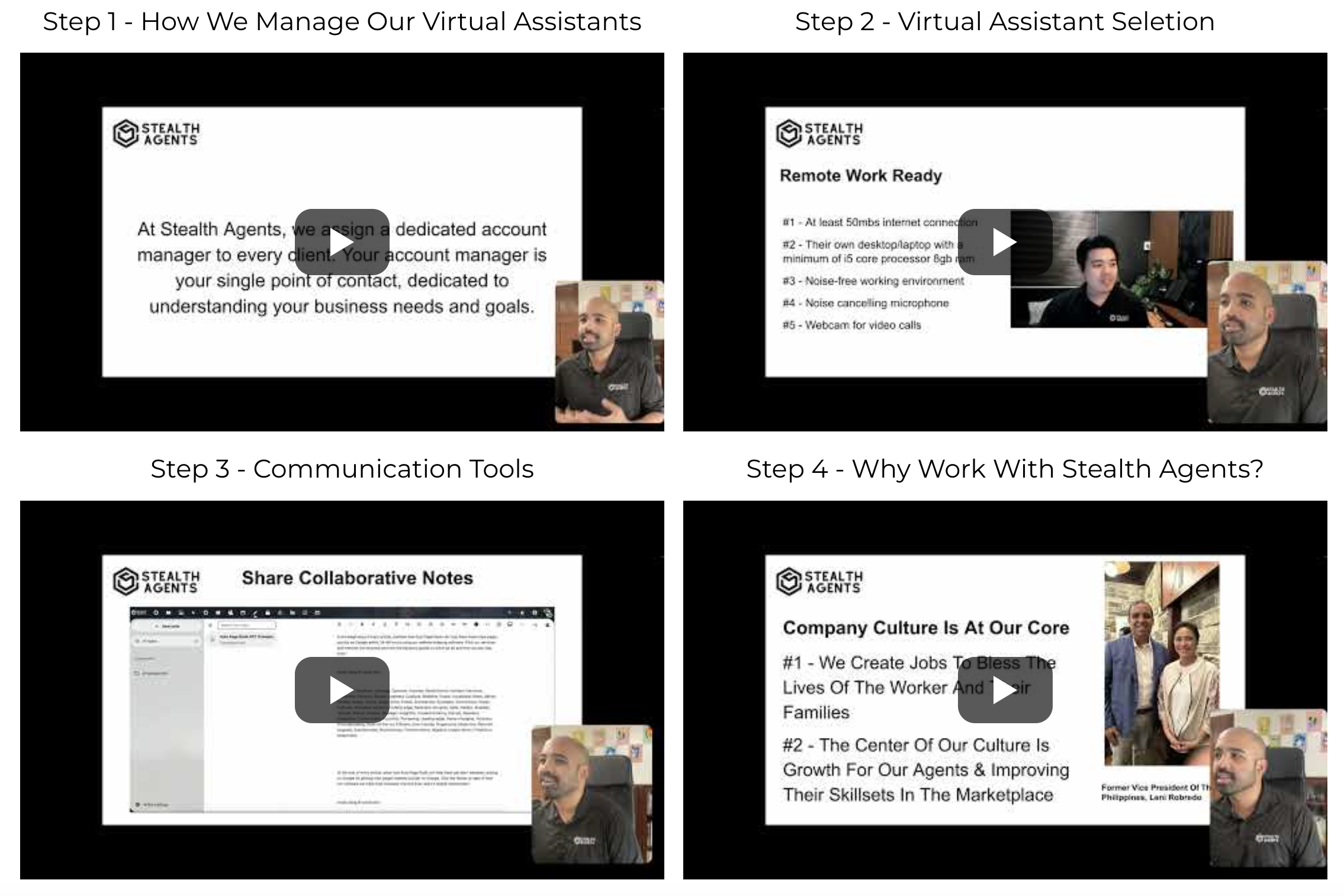Choosing between a virtual vs in-house assistant can be a thorny issue in the fast-paced business world. It can hugely affect your company’s output and bottom line.
Virtual assistants have been a complete game changer, offering up to 78% savings in operating costs compared with a traditional in-house employee.
With an average monthly savings of $1,566 per virtual assistant, businesses reap substantial financial benefits while maintaining high productivity.
Beyond cost-effectiveness, virtual assistants provide flexibility and access to a broader talent pool, making them a compelling choice for modern enterprises.
However, in-house assistants can provide live, in-the-building support that certain businesses may want for certain services.
When weighing which best suits your needs, weigh price, comfort, and control.
Stealth agents have made this choice less complicated by helping people find or hire the right virtual assistant; it provides a free discussion to determine your needs and virtual assistant pricing.
What are the Differences between Virtual Assistant vs. In-House Assistant
There is a vast difference between virtual and in-house assistants, mainly in cost, flexibility, and accessibility.
Virtual assistants save companies massive amounts of money, often reducing their operating expenses by as much as 78% compared to that of a regular in-house employee, which is attractive for cost-sensitive business entities.
They help companies tap into a global talent pool and can hire the best from any country, free from geographical limitations.
This arrangement works best for tasks that do not require an office worker to be present in the office environment, such as scheduling, support, and management of all the networking sites.
In contrast, in-house assistants are based on-site and can offer prompt support with face-to-face interaction, which could facilitate tasks requiring personal engagement or direct supervision.
Nonetheless, in-house staff will raise costs due to the required salary, wage, benefits, and office space.
Ultimately, the choice to work with a virtual assistant or an in-house one depends on a business’s specific needs or budget and the nature of the work management required.
How to Decide Between a Virtual Assistant vs In-House Assistant?
1. Evaluate Your Budget
Virtual assistants often present a cost-effective solution, making them ideal for startups and businesses aiming to minimize overhead expenses.
They remove the need for extra office space, equipment, and employee benefits, leading to substantial cost savings.
This cost-effectiveness enables companies to redirect resources toward other critical areas of growth and development.
Conversely, in-house assistants may require higher financial investments due to the need for physical workspaces and associated costs.
Assessing your budgetary constraints and long-term financial goals is crucial in making an economically sound decision.
2. Assess the Nature of Tasks
Consider the tasks that require assistance to determine the most suitable type of assistant.
Their expertise and flexibility make virtual assistants ideal for roles requiring specialized skills, SEO, or IT support.
They are well-equipped to handle tasks that demand a high level of specialization and require staying updated with industry trends.
Conversely, tasks that require a personal touch or routine administrative work benefit more from an in-house assistant’s proximity. In contrast, Philippines administrative support can offer a cost-effective alternative for handling tasks remotely.
Understanding the nature and complexity of the functions will help you select the assistant that can provide the most value.
3. Determine the Need for Physical Presence
Physical presence is critical when choosing between a virtual assistant vs in-house assistant.
Tasks involving hands-on activities, such as event organization or in-office communication, often necessitate an in-house assistant due to their on-site availability.
They provide immediate support and ensure seamless execution of tasks that cannot be managed remotely.
However, functions that can be effectively handled through digital platforms may not require a physical presence, making a virtual assistant a viable option.
Evaluating the physical demands of your business activities will help determine the most appropriate assistant for your needs.
4. Analyze Task Frequency
Consider the frequency of tasks to decide whether a virtual assistant vs in-house assistant is more suitable for your business.
Virtual assistants offer significant flexibility, allowing companies to adjust hours and availability according to project demands.
This adaptability makes them ideal for project-based work or tasks with fluctuating workloads. An in-house assistant might provide more consistent and reliable support for ongoing, routine tasks.
Understanding the frequency and variability of tasks will help you determine which type of assistant can best accommodate your business model.
5. Consider Team Integration
Integrating an assistant into your team is vital for maintaining a cohesive work environment.
In-house assistants can seamlessly become integral team members, enhancing company culture and facilitating immediate communication and collaboration.
Their physical presence can strengthen workplace relationships and encourage a collaborative atmosphere.
However, virtual assistants can integrate into teams using digital collaboration tools, providing skilled support without location constraints.
Weighing the benefits of team integration against the advantages of Filipino outsourcing will help you make a decision that supports team productivity and morale.
6. Align with Long-Term Goals
Choosing a virtual assistant vs in-house assistant should align with your business’s long-term objectives and operational strategies.
Consider how each option supports your vision, whether expanding into new markets or increasing operational efficiency.
Virtual assistants can offer scalability and specialized skills that align with dynamic growth strategies. In contrast, in-house assistants provide stability and continuity essential for specific business models.
Reflecting on your long-term plans ensures that your choice contributes positively to your company’s trajectory.
7. Conduct a Thorough Assessment
Evaluating your operational needs and financial impact is critical to making a well-informed decision.
Referring to virtual assistant bloggers, you can analyze the complexity and nature of tasks to evaluate how each type of assistant can effectively address these needs.
Consider budgetary constraints and the potential return on investment each option offers.
Additionally, consider the impact on team dynamics and how each assistant aligns with your company’s culture and objectives.
By thoroughly evaluating these factors, you can ensure that your choice of assistant supports immediate needs and long-term business growth.
What are Common Challenges Before Integrating virtual assistants vs in-house assistants?
-
Communication Barriers with Virtual Assistants
One of the challenges that virtual assistants pose is communication. Issues arise because they are from different locations; sometimes, time zones prevent instant discussions to help create clear interaction protocols.
More reliance on digital communication can lead to misunderstandings or delays, thus influencing productivity.
For businesses utilizing outsourced business intelligence, it is vital to implement effective communication platforms and practices to bridge these gaps.
Regular virtual meetings and updates help maintain alignment and ensure everyone is on the same page.
Language and cultural differences also pose challenges, requiring sensitivity and adaptation from both parties.
Effective communication strategies are essential to harness the full potential of virtual assistants.
-
Technology Dependence and Security Concerns
Virtual assistants rely heavily on technology, which can present software compatibility and cybersecurity challenges.
Companies must ensure that their systems are set up to support remote work, including secure access to necessary resources.
Regular updates and maintenance of communication tools and project management software are crucial to prevent disruptions.
Security protocols must be robust to protect sensitive information, which might require additional investment in cybersecurity measures.
Training virtual assistants using specific tools and software can also take time and resources.
Moreover, businesses should be prepared for potential technical issues and have contingency plans.
A seamless and secure technical environment is key to successful virtual assistant integration.
-
Cultural and Work Style Differences
Integrating virtual assistants from diverse backgrounds can introduce cultural and work style differences that must be managed effectively.
These differences can influence communication styles, work habits, and expectations, potentially leading to friction if not addressed.
Businesses should foster an inclusive environment that respects and values diverse perspectives. Providing cultural awareness training and establishing a company culture that embraces diversity can help mitigate these challenges.
Clear guidelines and expectations should be communicated to align work styles and ensure smooth collaboration.
Building a strong team culture that transcends geographical boundaries can enhance cohesion and productivity. Businesses must be flexible and open-minded to accommodate different work styles.
-
Onboarding and Training Processes
The onboarding and training processes for virtual assistants can be more complex than those for in-house assistants, primarily due to the remote nature of the role.
Businesses need to develop comprehensive training programs that can be delivered effectively online.
This includes creating detailed documentation and resources that virtual assistants can access independently.
The lack of in-person interaction can make conveying company culture and expectations challenging.
Regular check-ins and feedback sessions facilitate a smoother onboarding experience.
Investing time in setting up structured training and onboarding processes is crucial for integrating virtual assistants effectively.
Patience and proactive communication ensure virtual assistants feel supported and integrated into the team.
-
Space and Resource Management for In-House Assistants
Integrating in-house assistants often requires additional physical space and resources, which can be challenging for businesses with limited office capacity.
Allocating workspace, equipment, and supplies involves logistical planning and potential cost implications.
Businesses must assess their available resources and plan to accommodate new team members.
This can involve reconfiguring existing office layouts or investing in additional infrastructure.
Resource management extends beyond physical space, including access to technology and software necessary for the assistant’s role.
Companies must ensure that in-house assistants have everything they need to perform their tasks efficiently.
Effective resource management is essential to creating a conducive working environment for in-house staff.
-
Higher Costs and Financial Considerations
Employing in-house assistants typically incurs higher costs than virtual assistants, including salaries, benefits, and other overhead expenses.
Businesses must evaluate their budget and financial capacity to sustain these costs over time.
The financial implications of hiring in-house assistants include increased expenses for health benefits, office maintenance, and other employee-related costs.
These financial considerations can impact the overall profitability and financial health of a business.
Companies should conduct a thorough cost-benefit analysis to determine if the investment aligns with their strategic goals.
Exploring flexible staffing solutions or hybrid models can offer a balance between in-house and virtual assistance.
Careful financial planning is necessary to manage the costs associated with in-house assistant integration.
-
Management and Supervision Challenges:
Managing and supervising in-house assistants can present challenges related to time and resource allocation for managers.
Direct supervision requires managers to allocate time for oversight, performance evaluations, and day-to-day interactions.
This can divert attention from other strategic tasks and responsibilities, impacting overall efficiency.
Developing effective management practices and delegating responsibilities can streamline the supervision process.
Additionally, aligning the assistant’s role with organizational goals and performance metrics is essential for effective management.
Creating a supportive environment with opportunities for professional development can enhance job satisfaction and performance.
Balancing management duties with other priorities is a common challenge when integrating in-house assistants.
How much does it cost to Hire a Virtual Assistant vs In-House Assistant?
When deciding between hiring a virtual assistant vs in-house assistant, cost is crucial.
Virtual assistants typically charge $10-15 per hour, making them an affordable option for many businesses.
Virtual assistants may charge $13-15 per hour for more specialized roles, like executive support.
In contrast, hiring an in-house assistant involves additional expenses, including salary, benefits, and the cost of office space. Here’s a quick comparison:
| Type of Assistant | Cost per Hour | Additional Costs |
| Virtual Assistant | $10 – $15 | None |
| Executive Virtual Assistant | $13 – $15 | None |
| In-House Assistant | Varies | Salary, benefits, office space |
What are the factors When Choosing a Virtual Assistant vs In-house Assistant?
Several key factors must be evaluated to determine whether a virtual or in-house assistant best fits a business.
Beginning with budget constraints, virtual assistants are often a more cost-effective option, especially for startups or small businesses that want to minimize overhead costs.
Next, consider outsourcing to a virtual assistant; a virtual assistant might be ideal if tasks require specialized skills or can be done remotely.
However, an in-house assistant may be necessary if tasks demand physical presence or hands-on involvement.
Align the choice with your business goals, assessing whether flexibility and scalability are priorities that a virtual assistant could better support.
Additionally, consider the role of technology and communication tools that facilitate the management of virtual assistants, ensuring seamless collaboration and productivity.
Ultimately, the decision should reflect your long-term objectives and operational needs, balancing efficiency and budgetary considerations.
Why Choose Stealth Agents when Hiring Virtual Assistant vs In-House Assistants
Stealth Agents is the premier choice for businesses seeking efficiency and growth.
With a vast pool of skilled virtual assistants, Stealth Agents provides unmatched expertise and flexibility, allowing businesses to access top talent without the geographic constraints of in-house hiring.
We offer affordable services customized to your unique needs, providing personalized support that aligns with your business goals.
By choosing Stealth Agents, you gain a partner dedicated to matching you with the right talent, optimizing your workflow, and enhancing your business productivity.
Let us help you navigate the complexities of your staffing decisions and propel your business forward with the right virtual assistant solution.
Takeaways
Choosing between virtual assistant vs in-house assistants depends on understanding your business’s unique needs and goals.
By evaluating factors like budget, task requirements, and the importance of flexibility, you can make an informed decision that enhances efficiency and promotes growth.
Outsourcing to a virtual assistant provides numerous advantages, including cost savings and access to a diverse talent pool.
Stealth Agents stands ready to assist you in finding the perfect match for your operational needs.
We invite you to call us for a free discussion to explore your preferences and pricing options, ensuring you make the right choice for your business’s success.













